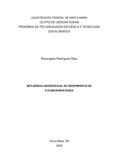| dc.creator | Dias, Rosangela Rodrigues | |
| dc.date.accessioned | 2021-11-26T12:31:04Z | |
| dc.date.available | 2021-11-26T12:31:04Z | |
| dc.date.issued | 2020-03-04 | |
| dc.identifier.uri | http://repositorio.ufsm.br/handle/1/23001 | |
| dc.description.abstract | Microalgae are photosynthetic microorganisms from which a variety of compounds with
potential for application in different industry sectors can be extracted. As microalgae
productivity in outdoor cultivation systems depends strongly on sunlight, temperature,
and photoperiod, climate variability as a function of geographic position represents a
significant challenge for the standardization of commercial-scale production
processes. Therefore, the objective of this work was: (i) to map the performance of the
microalgae Scenedesmus obliquus CPCC05 in photobioreactors, (ii) assess the effect
of the climate variability according to geographical position in the biomass production
of the microalgae Scenedesmus obliquus CPCC05, (iii) assess the lipid composition
of the microalgal biomass, (iv) assess the fatty acid composition of the microalgal
biomass. The results showed significant variations in the microalgae productivity and
in the proportion of fatty acids. Under the light intensity of 2100.9 μmol.m-2.s-1,
temperature of 28.75 °C and day length of 12.52 h, it was obtained the highest
productivity of biomass (0.347 g/L.d) and lipids (0.048 g/L.d). The biomass productivity
ranged from 0.009 to 0.347 g/L.d and lipid productivity from 0.0008 to 0.048 g/L.d for
the different geographic positions. In parallel, the proportion of saturated fatty acids
ranged from 31.39 to 65.68%, monounsaturated from 8.28 to 28.72% and
polyunsaturated from 21.37 to 57.78%. The results of this work provide important
information about the effects of spatial and temporal variation of climate on the
photosynthetic metabolism of the microalgae Scenedesmus obliquus CPCC05. | eng |
| dc.description.sponsorship | Coordenação de Aperfeiçoamento de Pessoal de Nível Superior - CAPES | por |
| dc.language | por | por |
| dc.publisher | Universidade Federal de Santa Maria | por |
| dc.rights | Attribution-NonCommercial-NoDerivatives 4.0 International | * |
| dc.rights.uri | http://creativecommons.org/licenses/by-nc-nd/4.0/ | * |
| dc.subject | Microalga | por |
| dc.subject | Scenedesmus obliquus | por |
| dc.subject | Localização espacial | por |
| dc.subject | Clima | por |
| dc.subject | Microalgae | eng |
| dc.subject | Spatial location | eng |
| dc.subject | Climate | eng |
| dc.title | Influência geoespacial no desempenho de fotobiorreatores | por |
| dc.title.alternative | Geospatial influence on the performance of photobioreactors | eng |
| dc.type | Dissertação | por |
| dc.description.resumo | Microalgas são microrganismos fotossintéticos dos quais uma variedade de
compostos com potencial de aplicação em diferentes setores da indústria pode ser
extraída. Como a produtividade de microalgas em sistemas de cultivo ao ar livre
depende fortemente da luz solar, temperatura e fotoperíodo, a variabilidade climática
em função da posição geográfica representa um desafio significativo para a
padronização dos processos de produção em escala comercial. Em face disto, o
trabalho teve por objetivos: (i) mapear a performance da microalga Scenedesmus
obliquus CPCC05 em fotobiorreatores, (ii) avaliar o efeito da variabilidade climática
em função da posição geográfica na produção de biomassa da microalga
Scenedesmus obliquus CPCC05, (iii) avaliar a composição de lipídeos da biomassa
microalgal, (iv) avaliar a composição de ácidos graxos da biomassa microalgal . Os
resultados mostraram variações significativas na produtividade de microalgas e na
proporção de ácidos graxos. Sob a intensidade de luz de 2100,9 μmol.m-2.s-1,
temperatura de 28,75 °C e duração do dia de 12,52 h obteve-se a maior produtividade
de biomassa (0,347 g/L.d) e lipídeos (0,048 g/L.d). A produtividade de biomassa variou
de 0,009 a 0,347 g/L.d e a produtividade de lipídeos de 0,0008 a 0,048 g/L.d para as
diferentes posições geográficas. Em paralelo, a proporção de ácidos graxos saturados
variou de 31,39 a 65,68%, monoinsaturados de 8,28 a 28,72% e poli-insaturados de
21,37 a 57,78%. Os resultados deste trabalho fornecem informações importantes
sobre os efeitos da variação espacial e temporal do clima no metabolismo
fotossintético da microalga Scenedesmus obliquus CPCC05. | por |
| dc.contributor.advisor1 | Lopes, Eduardo Jacob | |
| dc.contributor.advisor1Lattes | http://lattes.cnpq.br/9203445906772879 | por |
| dc.contributor.referee1 | Furlan, Valcenir Junior Mendes | |
| dc.contributor.referee2 | Wagner, Roger | |
| dc.creator.Lattes | http://lattes.cnpq.br/7171102709399587 | por |
| dc.publisher.country | Brasil | por |
| dc.publisher.department | Ciência e Tecnologia dos Alimentos | por |
| dc.publisher.initials | UFSM | por |
| dc.publisher.program | Programa de Pós-Graduação em Ciência e Tecnologia dos Alimentos | por |
| dc.subject.cnpq | CNPQ::CIENCIAS AGRARIAS::CIENCIA E TECNOLOGIA DE ALIMENTOS | por |
| dc.publisher.unidade | Centro de Ciências Rurais | por |



